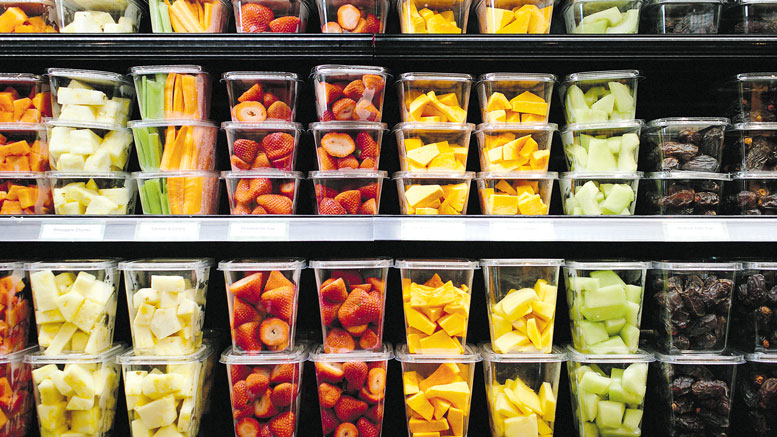Fresh-Cut Fruit is a Rising Star
June 25, 2024 | 7 min to read
Emphasizing freshness and quality, retailers are capitalizing on the growing interest in fresh-cut fruits. Despite inflation, 68% of consumers desire more convenient, pre-cut options. Retailers like New Leaf Community Markets and New Toronto Food Co. focus on maintaining high quality to prevent spoilage. They advocate for strategic merchandising and in-house preparation to enhance visibility and meet customer demand, especially among the Millennial and Gen Z demographics prioritizing convenience.

PHOTO COURTESY NEW LEAF COMMUNITY MARKETS
Emphasize freshness and quality to build a growing program.
Originally printed in the June 2024 issue of Produce Business.
Fresh-cut fruit is nutritious, convenient, and offers interesting choices for snacks, salads or as ingredients for just about any daypart meal.
Convenience is the key word here for consumers, and it trumps inflation as a driving force in produce.
“Despite inflation, more consumers are turning to valued-added produce — pre-cut and washed, as well as packaged salads — which provide convenience, but typically come with a higher price point per pound,” FMI, The Food Industry Association and 210 Analytics reported to the Southeast Produce Council’s annual Southern Exposure event in March.
“The majority of shoppers, or 68%, say they’d like their store to carry a bigger selection of these time-saving produce products, despite higher prices and inflation.”
TIME IS MONEY
The power of convenience resonates with some retailers.
“Customers are often pressed for time and willing to pay more for fresh product that is prepped and ready to use in order to save a bit of time,” says Kathleen Krantz, senior director of perishables for New Leaf Community Markets, Santa Cruz, CA. “While we will always see more sales in fresh, whole product, fresh-cut options are an excellent way to add convenience for customers.”

PHOTO COURTESY NEW LEAF COMMUNITY MARKETS
New Leaf Community Markets features local, organic produce, and has four stores in Santa Cruz County. It is owned by Portland, OR-based Good Food Holdings, a holding company that also owns Bristol Farms, Metropolitan Market, Lazy Acres Natural Market and New Seasons Market.
A few of the year-long customer favorites include cubed pineapple, cut watermelon or a mixed berry bowl with organic strawberries, blueberries and blackberries, says Krantz.
“While we find that most customers are entering the store at the produce department and have fresh, organic produce in their carts, there are others that come in for a quick shop and need something to round out their meal,” she adds. “Adding additional sets outside of the department has helped to capture some of those sales and adds another item to the basket.”
A well-managed fresh-cut fruit program pays a premium, because consumers are willing to pay more for the convenience.
“Fresh-cut is no longer a concept designed to offset shrink. You need to have top notch inputs to ensure a high-quality product.”
— Ezio Bondi, New Toronto Food Co., Toronto, Ontario
“I think the Millennial/Gen Z generations have been conditioned to pay a premium for convenience,” says Ezio Bondi, co-founder of New Toronto Food Co., Toronto, Ontario. “Busy Millennials, who are just starting their journey as parents, are the key demo.”
“Strong branding, and a 360-degree approach to marketing are what drive sell-through,” Bondi emphasizes. “As a partner, you need to be doing more than just making the sale. You need demos, a robust promo calendar, and a brand that can be a conduit to drive awareness outside of the store and across media channels.”
New Toronto Food Co. is a 7-year-old fruit and vegetable processor and repacker.
MONITOR QUALITY
While fresh-cut fruit offers produce retailers an excellent opportunity, this is not an easy category to get right.
The challenge starts with making sure the product begins and remains of the highest quality. Once the product is processed or cut, the spoilage spiral escalates. And it’s a mistake to see fresh-cut as a way to get rid of surplus berries and melons that are about to go bad.
“As the saying goes, ‘quality in, quality out,’” says Bondi. “Fresh-cut is no longer a concept designed to offset shrink. You need to have top-notch inputs to ensure a high-quality product.”
“I don’t think there is a difference between retailers or processors producing the product as long as there is respect for fresh-cut as its own category and not as a mechanism to offset shrink,” says Bondi.
Because fresh-cut fruits go bad quickly, it is important to be vigilant in monitoring how long the product has been on display, whether it was prepared in-house or by a processor.
Packaged fresh-cut commodities should be stored between 32- and 41-degrees Fahrenheit, and shelf life for fresh-cut varies depending on the commodity and product.
The most perishable fresh-cut items, with a shelf life of only two to nine days, are strawberry slices, melon chunks, mango cubes, citrus segments, sliced kiwi, peaches or pears, and berries. Apple wedges, pineapple chunks, and pomegranate arils have an expected shelf life of 10 to 14 days.
The short shelf life for cut berries and melons means produce department staff needs to cull the product regularly.
“Making sure the dates are right is important,” says Matt Taylor, produce manager at Tadych’s Marketplace Foods, Iron Mountain, WI.
“Six- and 12-ounce packs of mixed fruit are our most popular, with cantaloupe, honeydew and some berries,” says Taylor. “It’s been pretty steady.”
While melons and berries are the most established fresh-cut fruits, there is room for innovation, especially with tropical fruits.
“We’re seeing lots of demand for innovation in the space,” says Bondi. “Jackfruit, dragonfruit, mango, and other exotics in a value-added format are in vogue, as retailers look to differentiate their assortments from the usual suspects.”
DRAWING ATTENTION
Merchandising this fast-growing category begins with making it visible and attractive to shoppers.
“Placement is probably most important,” says Taylor, “I have a row of glass doors with bright lights that show the colors.”
And fresh-cut fruits must be displayed where consumers will find them easily.
“Fresh-cut needs to live in the five-deck section of the store,” advises Bondi. “Bunker placements see lower sales.”

PRODUCE BUSINESS/SUSAN CROWELL PHOTO
It helps to make these products visible and prominent in the store’s online presence, as well, he adds. “The online shopper is looking to add efficiency to their eating routine.”
Visibility may be the key to first-time sales, but freshness and quality of the product are essential for building the fresh-cut fruit program.
While most markets have chosen the labor-saving alternative of sourcing their fresh-cut fruits from outside processors, New Leaf prefers to prepare their fresh-cut fruits in-house.
“We prep everything we can for our ‘Chop Shop’ fresh-cut offerings in-house within our produce teams,” says Krantz. “In our stores, we merchandise fresh-cut fruits, veggies, and house-made dips where the customer shops for easy meal solutions and nutrition on-the-go.
“Outside of the produce departments, we feature the house-made salsa and guacamole within perishable grocery sets with other local vendors and feature fresh fruit options in the prepared foods coolers with fresh-made sandwiches, salads and burritos.”
New Leaf finds the effort needed to build a fresh-cut program in-house more than pays for itself.
“We have found that, while this is a successful and high-margin program, it does require a significant amount of skilled labor to cut everything in-house like we do,” says Krantz.
“We train our teams on how to select products, but find that, like most skills, on-the-job experience is the best way to continue to improve our offerings. Our clerks have learned what does or does not sell within their store, how the product fits in the containers and packaging, and when quality is the best.
“Our rule of thumb for the clerks is if you would not purchase or eat it, how can we make it a better product?”
1 of 16 article in Produce Business June 2024

